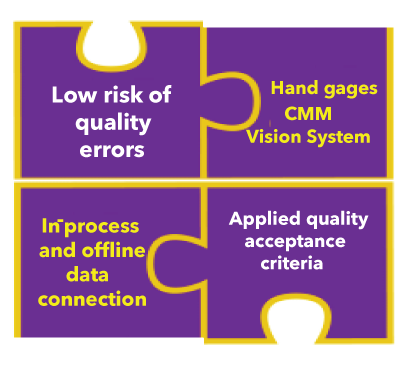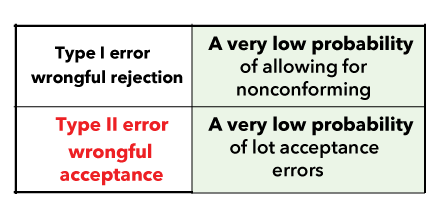Machine shops are faced with a balancing act between an amount of inspection data and the risk of acceptance errors. To achieve that balance, an approach based on low-risk acceptance at the point of production is the only viable option.
The issue is how to determine the risk of quality acceptance errors for the purpose of protection of producers and consumers against wrongful decisions. The new strategy of operation-specific process recognition and low-risk quality acceptance is offered by the knowledge-based system MICRONITE. Primarily, differentiation between risks of Type I and Type II errors is erased. Single-purpose risk of acceptance errors is negligible due to the predictive nature of process control and inspection interval monitoring. Results of random sampling are automatically supervised by the knowledge-based system.
MICRONITE’s methodology of data analysis dramatically reduces the risk of quality acceptance errors
For quality acceptance purposes, the industry is operating on computation of indexes Cpk and Ppk. Calculation for Sigma requires the process to be in a state of statistical control. If not in control, calculation of Sigma (and hence Cpk) is useless – it is only valid when a process is in statistical control. The existing methodology of direct computation of risks of errors Type I (the chance of rejecting an acceptable lot, producer’s risk) and Type II (the chance of accepting a defective lot, consumer’s risk) is based on null hypothesis. The validity of this method depends on normality of distribution for observed data. Obviously, the hypothesis applied to random sampling has rarely been tested in discrete part manufacturing. In reality, producers are limited with methods which manifest in failure to provide sufficient reliability of quality data, control of complex processes, and ensure error-proof product certification.
Realistically, the industry functions at a low level of data reliability and does not use sufficient statistical measures of conformance to specification. The traditional statistical basis of quality systems begins to appear obsolete. Analytical capabilities of process control remain in the embryonic state. Other generic methods such as R&R, APQP, and c=0 (MIL-STD-105E) do not meet demands of modern tight-tolerance machining and grinding. Majority of managers and executives are reluctant to change the status quo on both sides of product acceptance: consumers and producers. Notwithstanding obviously misleading acceptance criteria, consumers demand adherence to these core quality tools. Worse, they demand values of Cpk over 1.33 in the tight-tolerance environment where 1.33 can be achieved only with “data doctoring”. Both sides face a significant dilemma: to turn a blind eye on shortcomings of existent process and quality control methodology or pursue the new strategy of operation-specific process recognition and low-risk quality acceptance.
Such strategy and software tools are offered by the knowledge-based system MICRONITE. Primarily, differentiation between risks of Type I and Type II errors is erased. This risk is negligible due to the predictive nature of process control and inspection interval monitoring. Random sampling is automatically supervised by the knowledge-based system. Acceptance certificates are automatically compiled by computation of distributional and non-distributional parameters. The software can handle complex calculations very quickly and store large volumes of results so the user can investigate risk information in real-time. Machining-oriented modernization of core quality tools is absolutely necessary for achievement of well-informed decisions. MICRONITE helps strike the right balance between reliability of quality acceptance and inspection expenses. Surely, it will satisfy managers and executives on producing and receiving sides of product assessment.
Contradictions and controversies in process and product evaluation by Cpk
- Contradictions and controversies in process and product evaluation by Cpk
- The user is unaware of computation method for sigma estimate and its effect on the value of capability indexes. Difference in computational method has a huge effect on the value of Cpk.
- As a rule, part measurements that reflect non-linear unidirectional nature of machining process do not fall under assumption of the central limit theorem and can carry a big error of CP/Cpk value. It’s easy to understate or overstate the process capability. Raw data can be misinterpreted to get a phony Cpk
- Cpk fails to account for useful process shift from proximity to spec limit to the nominal when the value of Cpk is fallen instead of improving. This situation is typical for any machining operation
- Cpk is independent of the target, e.g. it fails to account for process shift with symmetric tolerances and presents an even greater problem with asymmetric tolerances
- In-process adjustments and tool changes can distort capability assessment because each individual process has its own distribution pattern
- Capability index Cpk is not lessened if individual measurements, not averages, are out of specification, We cannot use capability indexes for product certification unless we do not take in consideration the individual measurements and sample size.
- Lot Cpk of 1.33 could be hiding a whole lot of poor capability values, offset by some very high values, leading to a false sense of compliance with target performance




